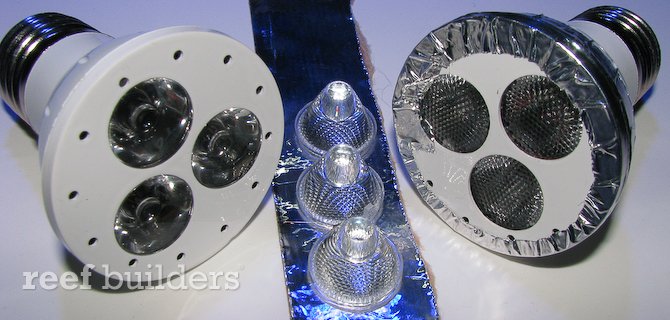Disclaimer! The following article is intended for entertainment purposes only. Any attempt to repeat this uber delicate surgical procedure could result in death, serious physical harm, electrocution, blindness, fire, death, impotence, sea sickness, drowning, death and perhaps qualify you for a Darwin Award. Do not try this at home.
A few months ago I invested in a handful of very narrow angle blue LED spotlights. The stock 10 degree lenses produced a light spread which was way too narrow for my purposes and once I got my hands on nanoCustom’s PAR 38 LED spotlight, these things went on the shelf and began to collect dust. I was messing around with one of them one day and managed to pop off the top and it quickly dawned on me that I could salvage these perfectly good LEDs by swapping out the lenses to a much broader optic that could give me the kind of spread I want and need. This mod came along very well and I thought the result was good enough to share with our DIY enthusiasts. Follow the break for the full walkthrough but still, I am a trained marine biologist so don’t you even think of trying this at home.

Here is a typical narrow angle LED spotlight, the likes of which can be purchased from SuperbrightLEDs.com. A 3 watt lamp is about $20.
~

For this mod I used 3 extra Cree 40 degree lenses and a small strip of aluminum foil tape.
~

You can clearly see the rim of the cap which holds the lenses in place in this LED spotlight
~

A little elbow grease and the lens holder pops right off, without any damage.Herre you can see the stock 10 degree lenses and the built in heat sink of this spotlight.
~

With all but one of the lenses removed this lamp throws light all over the place.
~

In this view all ot the lenses are gone and the bare LEDs can be clearly seen
~

I really like how the heatsink of this lamp is internalized
~

On the lest you can see the stock 10 degree lens and on the right, the Cree 40 degree optic which will replace it
~

the top two lenses are 40 degree and the bottom one is the stock 10 degree
~

In this view you can clearly see that the 40 degree lenses are a wee bit larger than the 10 degree lenses. This will require a slight trick to get the lens holder to stay.
~

All of the lenses have been swapped out to the desired 40 degree optic
~

When the cap or lens holder is replaced, there is a gap keeping the cap from snapping back in place because the new lenses are a little bit larger than the old ones.
~

A quick wrap around with aluminum foil tape and this thing is sealed shut, with the cap and the lenses in place.
~

Another look at the aluminum foil tape, holding down the cap and lenses but also blocking the majority of the vent holes
~

A couple japs with a pushpin and our vent holes are once again free to circulate air inside the lamp
~

The measuring tape in the center is about 20″ from the top to the bottom of the image.This is what the spot looked like with the stock 10 degree lenses with the lamp about 18″ away from the wall. The light is very concentrated but also highly variable in intensity from the center to the edge. Too much light in the middle, not enough on the periphery.
~

This is the appearance of the spot after the modification, now using the 40 degree lenses. The light spread is much broader and much more even than it was before.
~

Here is a side by side comparison of the same lamp model: on the left is the spread of the 40 degree lenses and on the right is the spread of the 10 degree lenses. Basically the spread went from 8-10″ in diameter to a fairly even 16-18″ in diameter at a distance of roughly 18″ away from this wall.
~



